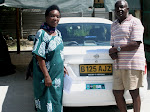


Maun, Botswana
Sept. 27, 2008
(blogger is letting me down again. lots more art and scenes to come....)
I have always liked the saying, “Life is short; art is long.” This week I had another reason to embrace the adage.
I spent the week at the edge of the Makgadikgadi Pans National Park at Leroo La Tau Lodge. That’s where hundreds of zebra parade to the water hole, and their friends the wildebeests meet them there. I will always remember the distinctive sounds of Leroo: the strange honking, barking noises that zebra make and the beat of their hooves when they are spooked by the least little thing, even a shadow. This week the sounds included the bellows of vociferous lions at close range. I could hardly sleep from the excitement of hearing those roars that can shake a bedridden body right through to the core. One sounded as though it was just outside my room, but I couldn’t find tracks to confirm it.
But back to the art.
I stayed at the lodge to be near Khumaga, a village of 800 people 6 kilometres away. As the DDS volunteer, I went to the Khumaga Primary School Monday through Thursday afternoons to conduct the Khumaga Primary School Art Project. I took a cue from Bana Ba Letsatsi and devised an idea for a DDS community project to raise money for the number one item on the school’s wish list: new traditional dance costumes for their students. Any child who wanted to participate would draw on Monday, and then 30 children would be asked to paint versions of their drawings on fancier paper the rest of the week. We plan to sell the paintings in DDS curio shops, with all proceeds going to buy the costumes. (To see the kind of costumes I’m talking about, look at the Kanye dancers’ photo for my blog entry in July at Lally and Gerald Warren’s 25th wedding anniversary at Lobatse.)
I have this belief that we can learn a lot from children if we stop to listen – and I mean REALLY listen by being totally present. Children the world over, I believe, are innately gifted artists, singers, dancers and storytellers who can prompt us to remember our best selves. Somewhere along the way, especially in the United States, we grow up and find ourselves hammered, nailed and fitted into certain boxes. We close down. We lose our voices, our glorious sense of abandon, our bright-eyed willingness to say yes. We demur if asked to sing (guilty as charged). Mouthing the words becomes our m.o., even when attempting “The Star Spangled Banner.” No, we explain: We can’t draw so much as a stick figure. And, for Pete’s sake, don’t make me step away from this table to dance at the wedding; I’ve got two left feet. (There was a notable though less than inspiring hiatus during the unfortunate Macarena phase and, in Texas, during the call to the floor for the calamitous Chicken Dance. I blame it on the alcohol, and in this case beg anyone wishing to strut around to poultry music, opening and closing your fingers like a chicken’s beak, to take a seat.)
Aside from the Chicken Dance, I say what a pity that so many of us have put away our gifts like tattered teddy bears stuffed into a closet’s dark corner. We used to throw ourselves into the arts with grace and ease, without a whit of self-consciousness. I wonder if we can reclaim that state of being?
My hunch was that the students of Khumaga would delight us with their view of the world, and I was right. They live in an environment that today is largely sand – the color of sand adorns everything. A fine sand blows in great gusts throughout the day. You wipe it from your ears, your sunglasses, the keyboard of your laptop. Nearly all of the villagers’ houses are brown, as is the thatch of the roofs. The few trees to be found are brown and thorny with only a touch of green. A refreshing color is the light blue on the Botswana flag flying high over the kgotla, the gathering place of democracy for the village.
We are approaching the harshest time of the year in this country nicknamed the Thirst Land. The animals move slowly in clouds of dust to the few water holes around. Even the cattle forego grazing for hours to huddle under the shade of acacia trees. The children’s world – what they see every day – is brown save for the blue sky.
What would Khumaga children do with the colored pencils, crayons, magic markers, new brushes and tempera paints that Mpho Ditirelo, a DDS assistant manager, and I brought them?
You’ll see. They painted with abandon. With color. With smiling yellow suns, red flowers and even blue dashes to signal the most precious of blessings in these parts: rain.
In short, the project was a success, at least for this phase. Sixty-two children showed up the first afternoon to do their sketches. My good friend and exceptionally talented painter Frances Hairfield in Morganton, North Carolina, advised me by email not to make it a competition. All children will be doing their best art, she said. If there are “winners,” there will inevitably be disappointed children when there need not be.
And so I told the children, ages 7 through 14, that I knew all of them were artists, and all of their drawings would be shared with managers at the lodge and in Maun. I knew that all of their work would be wonderful. I never said “the best” would be asked to paint; just that some would be asked to paint in groups of 10 in the following days. (Mpho was there the first day to help me in case my Southern-accented English left them confused. She reassured them in Setswana.)
I saw children throughout the week grow in confidence and in pride in their work. On two days the painting sessions occurred under a tree in the courtyard when it was 105 degrees in the shade. The students never complained, even when the wind blew their precious paintings from their desks into the sand. When teachers weren’t around, other children sneaked up from behind and pressed in close to watch the painters work. I had to ask them to back off and give the artists room. That didn’t work. I went to the office to enlist an authority figure, and as soon as Mma Ghanzi appeared in the courtyard, the peanut gallery scattered in a flash, back to their classrooms.
Why were the participants mostly boys? I asked. A teacher told me that girls thought art was boys’ work. How strange, I thought but doubted the conclusion. I could tell as the week progressed that the girls were especially interested in seeing what was going on. I think they were just shy about trying in the first place. The teacher said more of the children every day wished they had joined in, girls included.
At the end of every session, the teachers wanted to see the finished work. They were so pleased. They reported that some children were busy sketching in class during the day in their composition books, to practice.
“They are doing their level best,” one teacher told me.
Which was quite fine indeed, especially for children who had rarely if ever had such brushes, paints and paper. The lack of materials was an obvious issue for the school.
The children didn’t say much to me as we worked together. They were quiet and serious. They wouldn’t so much as pick up a pencil until I said “Start,” which I needed to do until I asked a teacher why they weren’t drawing yet. They shared materials, flattened their hands on each other’s paper if the wind threatened to blow it away. They helped one another with advice in Setswana and sometimes with a careful brush or pen stroke on their neighbor’s paper. The gesture was always appreciated, it seemed. I knew, though, that the project had worked when I heard the children imitating my words. “Very nice. Excellent. Perfect!” They were encouraging each other, just as I had bent over their shoulders and proclaimed those words to them.
As a painter finished a piece, I would hold the art aloft for the children across the courtyard to see. The onlookers smiled broadly, giggled, waved and stamped their feet a bit in approval. The painters themselves stood taller. They loved the acclaim; I could see it on their faces. But most of all they loved making their art. One child did extra drawings and brought them to me as a gift. Another, Percy, did four in one night. There wasn’t time to finish painting them all, but he knew I thought his work was beautiful, and it pleased him.
Why is art long? I could see a spark ignite in these children. As long as the tempera paint lasts, they will be painting, to the delight and wonder of all of Khumaga.
P.S. If any of my friends out there see a painting you’d like, let me know. I can front the $25 (up to a point) on this side of the globe, then I can swap you the painting for the cash when I get back to the U.S.)





1 comment:
Pick out a painting for me -- I am eager to purchase one. Thais
Post a Comment